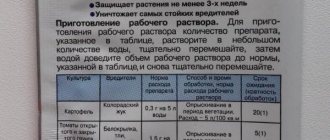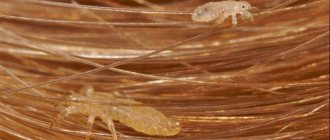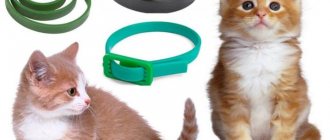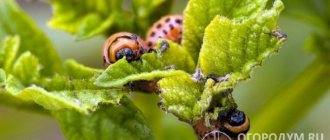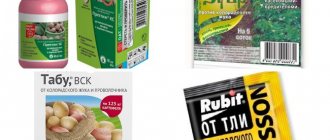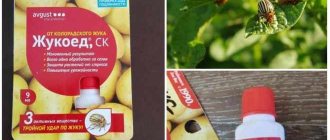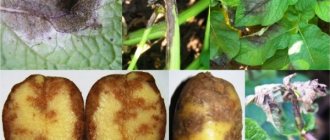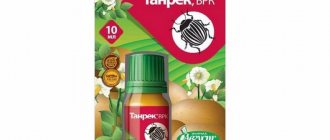Purpose and effect of the insecticide Komandor
Commander systemic insecticide is designed to combat leaf-eating and sucking pests.
The drug Commander is intended to combat various types of leaf-eating and sucking pests on potato, tomato, cucumber crops, as well as on flower crops.
"Commander" enters plants through leaves, stems and roots. Once in the body of the pest, the insecticide blocks the functioning of its nervous system, as a result of which the insect stops feeding, moving and ultimately dies.
The “Commander” drug remains on the surface of the treated crop, remaining toxic to new larvae emerging from old egg clutches.
Purpose
“Commander” insecticide is primarily used to protect potatoes from the Colorado potato beetle and vegetable crops in protected and open ground from whiteflies and aphids. It is also used to cultivate pastures and meadows.
“Commander” is also used for treating planting potato tubers from wireworms and planting seeds of corn, sunflower, etc. The line of preparations includes a special drug “Commander Plus” for special treatment of potato tubers before planting to protect against wireworms, mole crickets and Colorado potato beetles, enhanced with a stimulant .
Product effectiveness
The high effectiveness of the drug “Commander” is ensured by the active substance imidacloprid. It belongs to neonicotinoids - strong organic poisons. The share of the active substance in the produced drug is 200 g per 1 liter.
As a result of the action of imidacloprid, a systemic failure in the transmission of nerve signals occurs in the pest’s body. At first, the insects go into convulsions, then irreversible paralysis occurs, after which the pests die. Complete cleansing of treated crops occurs within a day or less.
“Commander” is also effective in combating pests living inside the soil: beet chips, click beetles and other species.
Mechanism of action
After spraying, Commander is quickly absorbed by all parts of the plant - leaves, stems, roots. Pests, in contact with vegetative parts or when eating them, absorb the active substance, which leads to blocking the normal functioning of the nervous system, immobilizing the pest and its further death.
Already in the first hours after treatment, the population of various pests will be destroyed. Complete purification of the cultures occurs within a day. Commander does not cause pest resistance to its active substance, which makes the product unique in its own way.
The period of protective action of the Commander insecticide is at least 2 weeks.
Instructions for use of the drug Commander
The solution for treating plants with “Commander” is made up as follows: an ampoule of the drug (1 ml) is first diluted in a small volume of water, then, stirring, the volume of the solution is increased to 2 - 10 liters. Plants should be treated during the growing season. During the flowering period, the drug should be used with caution.
Important! To treat plants, only fresh solution is used, wetting the leaves as evenly as possible on both sides. Storing the prepared solution is strictly prohibited.
When spraying crops, it is necessary to use personal protective equipment. Treatment should be carried out in clear and windless weather, in the morning or evening.
Plants can be treated with Commander no more than once every 15 days.
Instructions for use of the drug Commander
To combat the Colorado potato beetle in potato plantings, 5 liters of working solution are used per 100 square meters of crops. When controlling pests on cucumbers, tomatoes, and flower crops, 1 liter of working solution is consumed per 10 square meters. m..
The effect of the drug begins within 90 minutes. Preventive treatment can be carried out after 20-30 days. In addition, duplicate spraying after rain is justified - “Commander” can be washed off from plant leaves. The drug does not cause chemical burning of stems and foliage if the recommended dosage is not exceeded.
Compatibility with other drugs and analogues
Commander can be used in conjunction with other drugs, even those with similar effects. Its effect is not reduced by joint treatment of the crop with growth regulators, other fungicides and insecticides. The fungicide should be used with caution only in combination with drugs that give an alkaline reaction. Alkali reduces the effect of the main substance, which significantly reduces the effectiveness of the treatment.
Commander has several analogues on the market:
- Anti-Colorado;
- Youombardir Aqua;
- Confidor extra.
If the Commander himself could not be found in the store, then he can easily be replaced by the above means, and the culture will be saved. The preparations have insecticidal properties and will help destroy even large colonies of beetles.
Security of the product
The drug “Commander” has the third class of danger for humans, that is, moderately dangerous. At the same time, the insecticide is very dangerous for bees (hazard class 1). Therefore, it is fundamentally important to limit the number of bees for 4-5 days after spraying. The border zone is 5 kilometers from the place where the drug is used. “Commander” is toxic to fish, so its use in fishery zones is prohibited.
You should alternate the use of Komandor and other insecticides to prevent the development of drug resistance in pests.
[adsp-pro-5]
Advantages and disadvantages
“Commander” is a chemical poison with its pros and cons.
Advantages of the product:
- Stable, easy to use.
- Protects crops from diseases, suitable for prevention.
- Accelerates the development and growth of plants.
- Effective against larvae and adults.
- Does not cause addiction to the active substance.
- Long-term effect – up to a month.
- Affordable price.
The disadvantages include:
- Moderately toxic to humans.
- The product is dangerous for bees, fish, and birds that feed on insects.
- If personal safety rules are not followed, the insecticide can harm human health.
If you follow the instructions, the drug will not cause harm, it will only bring benefit.
Personal protective measures
Commander is combined with many other insecticides.
Spraying with “Commander” should be done with gloves, goggles, protective clothing and a respirator or gauze bandage. When processing plants, it is necessary to remove children and pets from the area of influence of the drug. When working with the drug, it is prohibited to drink, eat and smoke. Do not use food containers to prepare the solution.
After finishing working with the drug, you should rinse your glasses, boots and gloves with running water. The remaining solution must be diluted with water and poured down the drain or into a specially designated place. Empty insecticide containers should be burned. After this you need to take a shower and change clothes.
In what form is the product produced?
produces the drug “Commander” in the form of a liquid emulsion concentrate, sealed in ampoules and vials.
The ampoule and bottle are placed in blisters with detailed instructions for use and a recipe for preparing the solution, and safety measures for working with the drug are also indicated.
The capacity suggested by the manufacturer is as follows:
- ampoule 1 ml;
- bottle 10 ml.
Such dosages are produced both for the needs of those who have a relatively small area of vegetable crops, and for vegetable farmers with large farmland.
For your information! The “Commander” drug, in addition to treating potatoes, is designed to protect other planted vegetables - tomatoes, cucumbers, as well as ornamental plants and flowers.
First aid
If the drug gets into your eyes or skin, rinse the affected area with running water. Do not rub the area where the “Commander” drug came into contact. If the drug gets on the skin or eyes, they should be rinsed with plenty of running water. Do not rub your eyes or the area on the skin where the drug has come into contact.
If the insecticide is swallowed, it is necessary to take the victim out into fresh air, give him 4-6 tablets of activated carbon, wash it down with a glass of water. You cannot induce vomiting.
If the drug gets into the lungs, you must immediately remove the victim from the area treated by the Commander.
It is necessary to consult a doctor after providing first aid.
Commander, Military Military Command
Insecticidal systemic protectant of seeds and tubers of agricultural crops against pests of seedlings and soil-dwelling pests
Preparative form:
Water-soluble concentrate, VRK
Active ingredient, concentration:
Imidacloprid (200 g/l)
Chemical class: neonicotinoids
Advantages:
Due to the balanced formulation, the drug retains its properties in a wide temperature range from -30 to +55 C, which is convenient for storage and transportation.
Long period of protective action (up to 45 days)
Easy to use, easy to use, easily diluted in water, forming a stable aqueous solution.
Thanks to the presence of a high-tech solvent, the drug effectively penetrates into the seeds, and then systemically into the seedlings and young plants. European surfactants, thanks to their formulation, provide durable seed coating.
Saving money by eliminating insecticidal treatments during the growing season.
Mechanism of action: Commander® has pronounced systemic activity, penetrates into seedlings and young plants through the seed. It actively affects the nervous system of harmful insects, blocking nicotinergic receptors of the postsynaptic nerve. The drug quickly suppresses the transmission of signals through the central nervous system of insects, from which they initially lose motor activity, stop feeding, and then die.
Activity spectrum: Commander® is effective against pests from the orders Homoptera, Coleoptera, Lepidoptera and others. Both adult insects and larvae of different ages die.
Wireworms and other soil-dwelling pests, grain flies, Swedish flies, rapeseed flower beetle, Colorado potato beetle, aphids, thrips, nightshade miner, beet and cruciferous flea beetles, beet, carrot and cabbage flies, greenhouse whitefly, pest bug, blueberry, cutworm species, etc. .
Speed of influence: a few hours after treatment, insects stop feeding, death occurs within 24 hours.
Terms of use: Commander® (colored) is used to treat seeds immediately before sowing.
Period of protective action: up to 45 days.
Phytotoxicity: Neonicotinoids are not phytotoxic.
Selectivity: Imidacloprid is more selective for beneficial insects than synthetic pyrethroids and organophosphorus insecticides.
Standard packaging: 10-liter canisters or four 5-liter canisters in a multi-layer cardboard box.
Additional Information
Insecticidal systemic protectant of seeds and tubers of agricultural crops against pests of seedlings and soil-dwelling pests.
Hazard class: 3 (moderately hazardous compound) and class 2 for persistence in soil.
Restrictions on transportation, use and storage of the pesticide: store the drug away from medicines, food, fodder, seeds, and in places inaccessible to children and animals.
It is prohibited to work with the drug without personal protective equipment. The duration of work should not exceed 3 hours. Eating, drinking, and smoking are prohibited in the workplace.
Recommendations for the protection of useful objects of flora and fauna: in terms of the degree of impact on aquatic biocenoses, the drug belongs to hazard class 3 and is prohibited for use in the water protection fishery zone. The maximum permissible concentration of the drug for water in fishery reservoirs is 0.13 mg/l.
The drug is highly dangerous for bees (hazard class 1) when directly sprayed, as well as through drug residues on plants. Treatment of flowering entomophilous crops during the active summer of bees, as well as subsequent visits by bees to treated farmland earlier than the established period, are not allowed. In all cases of pesticide use, compliance with the basic provisions of the “Instructions for the Prevention of Bee Poisoning by Pesticides” (Moscow, Gosagroprom USSR, 1989) is required. The following environmental regulations must be observed: carry out ground processing of plants in the morning or evening hours; at wind speed – up to 1-2 m/s; border protection zone for bees of at least 4-5 km; bees' flight limit is 9-10 days. It is acceptable to conduct the test during the day in cloudy, cool weather, when bees do not fly out of the hive. It is necessary to mow flowering weeds along the perimeter of the cultivated field to the distance of possible drift of the drug.
First aid for poisoning: the victim must be immediately removed from work and removed from the area affected by the pesticide, carefully remove clothing and personal protective equipment from the victim, avoiding contact of the drug with the skin or respiratory system; in case of contact with skin, remove the drug with a piece of cloth or cotton wool (without rubbing it), and then wash the contaminated area with soap and water; In case of contact with eyes, rinse them thoroughly with clean running water; in case of contact with clothing - after removing contaminated clothing, rinse areas of possible skin contamination with water; in case of accidental ingestion, rinse the mouth with water, immediately give the victim a few glasses of water with activated carbon at the rate of 1 g of sorbent per 1 kg of body weight, and then induce vomiting by irritating the back of the throat (this should be repeated several times until the drug is completely removed from the body).
After providing first aid, consult a doctor immediately. There is no antidote. Treatment is symptomatic.
Telephone and address for emergency contact in case of poisoning: 129090 Moscow, pl. B. Sukharevskaya, 3, building 7. Federal State Institution "Scientific and Practical Toxicology Center" FMBA of Russia, tel., fax.
Safety measures during transportation, use and storage of the pesticide: those working with the preparation must be provided with personal protective equipment: overalls, safety glasses, gloves. During work, you should observe the rules of personal hygiene. After working with the drug, you should thoroughly wash your hands, face and exposed areas of the body with plenty of soap and water. In the event of an accident, consult a doctor immediately. It is advisable to have the container label with you.
Transportation and storage in accordance with GOST 14189-81, OST 6-15-90.4-90 and SanPiN 11.2.2584-10 “Hygienic requirements for the safety of processes of testing, storage, transportation, sale, application, neutralization and disposal of pesticides and agrochemicals.” Store the drug indoors in its original packaging in a dry, cool, well-ventilated place intended for storing pesticides.
Methods for neutralizing spilled or scattered pesticide: the spilled product is adsorbed with sand, dry soil, clay, sawdust until completely absorbed. Collect the contaminated sorbent in a special tightly closed container and remove it to places approved by territorial environmental authorities and State Sanitary and Epidemiological Supervision agencies. Contaminated areas of land are treated with a 10% alkali solution and then dug up.
Methods of destruction or disposal of pesticides: disposal of pesticide residues is carried out in accordance with the “Temporary instructions for the preparation and disposal of pesticides and their containers that are prohibited and unsuitable for use in agriculture.” (M., Agricultural Chemistry, USSR Ministry of Health, 1989).
Methods for destroying pesticide containers: disposal of pesticide containers is carried out in accordance with the adopted “Temporary Instructions for the Preparation and Disposal of Pesticides Prohibited and Unsuitable for Use in Agriculture and their Containers” (M., Selkhozkhimiya, Ministry of Health of the USSR , 1989).
Application regulations
Insecticidal systemic protectant of seeds and tubers of agricultural crops against pests of seedlings and soil-dwelling pests.
| Culture, processed object | Consumption rate of the drug l/t | Harmful object | Method, processing time | Frequency of treatments | Waiting period (days) |
| Corn (for grain) | 2,0 | wireworms | Pre-sowing treatment of seeds immediately before sowing or in advance of sowing (up to 1 year). Working fluid consumption: 10l/t | 1 | — |
| Sunflower (except green fodder) | 2,0 | wireworms | Pre-sowing treatment of seeds immediately before sowing or in advance of sowing. Working fluid consumption: 10l/t | 1 | — |
| Wheat | 1-1,5 | Bread ground beetle, flea beetles, grain flies, wireworms | Seed treatment before sowing. Working fluid consumption - up to 11.5 l/t | 1 | — |
| Potato | 0,2-0,25 | Wireworms, Colorado potato beetle, aphids | Treatment of tubers before or during planting. Working fluid consumption – up to 10 l/t (before landing), up to 25 l/t (during landing) | 1 | — |
Application technology: to achieve the maximum protective effect, you should strive to apply the drug evenly over the entire surface of the treated seeds and tubers.* - these crops are being registered
Compatibility with other pesticides: compatible with other insecticides, fungicides, growth regulators, agrochemicals, with the exception of drugs that have a strongly alkaline or strongly acidic reaction. It is recommended to check the components for compatibility before mixing
Procedure for preparing the working fluid: When preparing the mother solution, you need to use non-metal containers (polymer), or, as an exception, you can use containers made of stainless material.
The shelf life of the stock and finished working solution is no more than 4 (four) hours.
Treating seeds in advance or before sowing.
Dressing agents: PS-10, PS-10A, PSSh-5, Mobitox, Mobitox super, for corn - Reber.
The procedure for preparing the working fluid:
- fill the tank with water to 1/3 of its volume;
- Mix the required amount of the drug in a separate container with a small amount of water. When preparing the working solution, after 2-3 minutes a gel is formed, which is easily stirred to form a suspension. In this case, the temperature of the solution increases by 10-15°C;
- pour the stock solution of the drug into the tank, fill the tank with water to the required volume;
- turn on the mixing device before the disinfectant starts working;
- Continue stirring during processing;
- Use the working solution no later than 4 hours.
Working solution consumption: 10 l/t seeds and tubers
Reviews from gardeners about the drug Commander
Vasily Stepanovich. A good remedy, it helped us a lot against the Colorado potato beetle on potatoes. We treated it once and it lasted for the whole summer. We will definitely use it at the dacha from now on.
Anton. The drug is effective, it destroyed insects on tomatoes, cucumbers, and potatoes. The most important thing is not to poison yourself; be sure to wear boots, gloves, and a respirator. Then the pests will die, and you won’t even sneeze.
You may be interested in Trichodermin and its reviews. We recommend looking at the reviews of the fungicide Khom, following the link.
Svetlana. An excellent product for killing pests on tomatoes and cabbage. I tried to cultivate a small area of a potato field, there were no more Colorado potato beetles on it, the potatoes grew excellent. I didn’t treat the neighboring area; the beetle did a lot of damage there.
Full description of the insecticide
The action of the Commander is based on a special substance – imidacloprid. After applying the product to plants, it accumulates inside for 2 hours, and the effectiveness itself lasts for a period of 21 to 30 days. The insects eat the poison along with the green leafy mass, and then after a few hours complete paralysis occurs in the beetle’s intestines, causing the pest to immediately die. Most of the beetles die during processing. There is no need to repeat the process.
The insecticide is effective against both mature individuals and their eggs. To completely get rid of the Colorado potato beetle, it will take from a couple of days to several weeks, it all depends on the scale of the infestation and the number of colonies. In addition to the Colorado potato beetle, with the help of the Commander you can fight several other types of pests:
- whiteflies;
- fleas;
- flies;
- aphids;
- leaf roller;
- bedbugs;
- wireworm;
- thrips;
- whitefly.
The following crops are treated with the Commander:
- pumpkin;
- root vegetables;
- Solanaceae;
- legumes;
- cereals.
In addition to the destruction of various pests, the product has a protective ability. The composition contains nutritional components - minerals. They accelerate the germination of the crop, promote its active growth and further development. Even if the plant has already been attacked by the Colorado potato beetle, but was treated in a timely manner, the negative effect of the pest on the crop will be minimal.
Preparation of working fluid
How to prepare the Commander working solution:
Photo instructions for use from the manufacturer
How to fight aphids in the garden?
To choose the correct and effective control method, you need to understand where this pest comes from in the garden and what its biological characteristics are. Scientists know of 3,000 species of aphids, which are capable of infecting not only garden crops, but also cacti; combating them cannot be avoided. The insect has an elliptical body with a transparent cover; it not only crawls, but also jumps.
Treating the garden against aphids in the spring involves several different methods. For example, if the level of infestation of plants in the area is high, spraying is more suitable for control; the use of folk remedies is safer for the environment; if insects appear in the garden area from time to time, repelling can be used. Experts say that the choice of method for controlling aphids in the garden depends on the specific situation.
Types of aphids on garden trees
The most famous varieties of aphids in the garden:
- cherry;
- pear-umbrella (green and brown);
- peach;
- apple;
- apple-cereal;
- apple-plantain;
- pear leaf roller.
